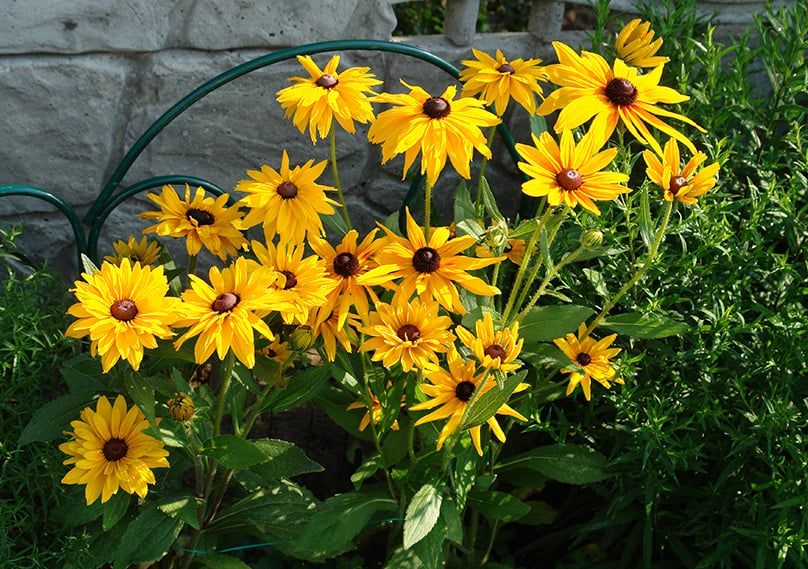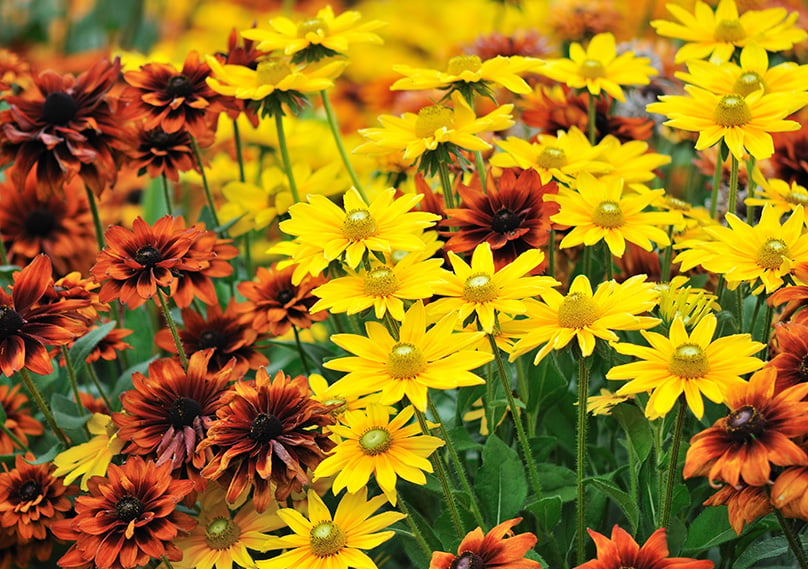The Black-Eyed Susan is the posterchild of the late summer season. As August starts to wind down, these cheery Rudbeckias begin to pop up in flowerbeds across the country. These flowers love being out in the full sunlight, stretching its petals to the sky to absorb the rays in the dying days of summer.
These bright, colorful flowers come in shades of orange, lemon-yellow, and gold. The plants bloom for weeks in the late summer, without any need for specialized care. The black-eyed Susan produces a pleasant sweet scent, and it attracts pollinators like bees and hummingbirds to your yard when they start to bloom.
The National Garden Bureau named this wildflower “Plant of the Year” in 2008, putting this species in the spotlight of gardeners around the country. As a result of its popularity, gardeners started cross-breeding different varieties, resulting in some exciting hybrids. Today, you can find the black-eyed Susan in various heights, forms, and colors.

The new hybrid varieties offer plenty of diversification for your garden, and they’re suitable for any style garden, from urban flowerbeds to prairie plots. The Rudbeckia is a proud member of the sunflower genus, (Asteraceae) with daisy-like flowerheads that lean toward the sun.
Also known as the “coneflower,” don’t confuse the black-eyed Susan with purple coneflowers (Echinacea purpurea), as they are an entirely different species. Susans are easy to grow, and they start from seed naturally in the ground after each season.
If you had multiple varieties of colors and sizes in your garden this year, leave them to seed. The following season you’ll have some beautiful hybrid colors popping up from seed as the summer starts to wind down.
What are the Growing Conditions Suitable for Black-Eyed Susan?
The black-eyed Susan comes from the coneflower family, but they have different colors, and the appearance of the bee and flower petals are different. However, the black-eyed Susan and the coneflower share identical growing conditions, and they prefer warmer climates.
The black-eyed Susan vine (Thunbergia alata), is another common form of the plant in gardens across America. This Rudbeckia is unrelated to the coneflower, and it’s a warm-climate perennial plant that’s native to African countries.
Black-eyed Susan grows best in USDA Zones 3 through 9. They like the warm weather, but they perish quickly without water in high temperatures.
What Is the Flowering Period for Black-Eyed Susan?
The Black-eyed Susan has an extended flowering period, showing up in the latter part of summer, blooming for around eight to ten weeks, depending on the environmental conditions. In most cases, the flowers start to appear in late July, early August, and they bloom through until the first frosts begin in November.
Some varieties, such as the ‘Early Bird Gold,’ feature extensive blooming periods. They’ll start producing flowers as early as the mid to late spring, bringing some color to your garden in the early part of the summer.

What Is the Maximum Height of Black-Eyed Susan?
The maximum height of this flower varies, depending on the variety. The tallest flowers reach up to 7-feet in height. This lanky stature makes them an excellent choice for the back of the flowerbed where they can tower above shrubs and smaller plants.
The smaller varieties may only reach 10-inches in height before they start to flower. These plants make great choices for lining the edges of flowerbeds.
What are the Characteristics of Black-Eyed Susan?
The black-eyed Susan is a pretty, flowering plant. The flower heads range from two to nine inches in diameter; and come in single, fully double, or semi-double arrangements. The most common varieties have yellow-gold leaves with black bees in the center.
Other common color varieties include orange-gold, and flushes of bronze, red, or mahogany. The bee or “eye” of the black-eyed Susan is more of a dark-brown color than black on closer inspection of the flower. Some varieties, such as the “Prairie Sun,” feature green eyes.
What are the Common Varieties of Black-Eyed Susan?
There are around 25 different varieties of Rudbeckia native to the North Americas. Many of these species are either short-lived perennials or biennials.
The plants can self-sow, and they’ll return to your flowerbed the following spring. If you mix different colors in your flowerbed, you can expect pollinators to mix up the pollination. As a result, you’ll see hybrid colors spring up in your garden the following summer.
The R. fulgida (orange coneflower), and the Rudbeckia hirta (common black-eyed Susan), are the most widely available varieties in the United States. Some of the other species worth mentioning include the following.
- R. nitida (the shiny coneflower)
- R. laciniata (the tall coneflower)
- R. maxima (the giant coneflower)
- R. subtomentosa (the sweet-scent coneflower)
- R. triloba (the brown-eyed Susan)
How Do I Plant Black-Eyed Susan?
Black-eyed Susan’s are readily available from your local nursery as bedding plants in the early springtime. However, it’s also important to note that they’re easy to grow from seed as well. Growing from seed also gives you many more varieties to choose for your flowerbeds.
Start sowing your seeds indoors during the early spring, around 10-weeks before the last frost dates in your area (check your local listings for frost dates.) You also have the option of sowing them directly to your garden in the spring or summertime when the ground starts to warm up.
Starting your seeds indoors gives you a more extended flowering season, and with deadheading, you can prolong the flowering season until the start of the winter. When germinating your seeds outdoors, wait until the soil reaches around 70° F for the best results.

Where Do I Plant Black-Eyed Susan?
Make sure you place your seeds or young Susan’s in a flowerbed that gets plenty of sunlight throughout the day. Susan’s require a well-draining soil with plenty of nutrition. The plants’ roots don’t enjoy saturation or soggy soils, and they’ll start to show signs of root rot from overwatering.
Make sure that your plant in an area that has good air circulation. Plants in close quarters in the cold, rainy conditions are likely to experience an infection with a mildew of white powdery.
Can I Sow Black-Eyed Susan Seeds Directly to My Flowerbed?
Yes, you can sow directly to your flowerbed in the summer after the frosts finish. Sow your seeds and cover them with a thin layer of topsoil.
Separate the plants as they start to sprout, ensuring you leave 6 to 12 inches between dwarf species, and 18 to 30 inches between perennial varieties. Water them well in the first few weeks until they establish root systems.
Can I Sow Black-Eyed Susan Indoors?
Sow seed indoors following the seed packet’s directions for planting depth, growing medium, and watering requirements.
As soon as the seedlings emerge, provide plenty of light by placing them on a sunny windowsill or beneath fluorescent plant lights (see Starting Seeds Under Fluorescent Lights).
Before planting your seedlings outdoors, be sure to accustom them to outdoor conditions by keeping them in a cold frame or another sheltered spot for a week.
- Quality Rudbeckia seeds packaged by Seed Needs. Packets are 3.25" wide by 4.50" tall and come with a full colored illustration on the front side, as well as detailed sowing instructions on the reverse.
- The plants grow to a mature height of roughly 12 to 36 inches tall and form clumps of beautiful golden yellow flowers, accented with deep brown centers.
- The blooms spread open to a diameter of about 2 or 3 inches wide. The Black-Eyed Susan is popularly chosen to attract beneficial insects to the garden, such as butterflies, bumblebees, ladybugs and even hummingbirds as well.
- Categorized as a perennial flowering plant, Rudbeckia will grow the first year from flower seeds and later return the following year from deeply established roots.
- All Black-Eyed Susan seeds sold by Seed Needs are Non-GMO based seed products and are intended for the current & the following growing season. All seeds are produced from open pollinated plants, stored in a temperature controlled facility and constantly moved out due to popularity.
- More Seeds- Our black eyed susan seeds packets have more than 2-3X as many seeds as many of our competitors with over 2300mg. Many only have 500 mg.
- NON-GMO, HEIRLOOM, OPEN POLLINATED: Our black eyed susan seeds for planting indoors or outdoors are of the highest quality with some of the highest germination rates in the industry.
- HAND PACKAGED BY A VETERAN OWNED SMALL FAMILY BUSINESS: If for any reason you are unhappy with your purchase, contact us and we will make it right. If you want customer service where you will talk directly to the owner for any concerns, we are the company for you!
- Be sure to check out or other seed kits including, herb kits, vegetable kits, wildflower kits, and more.
- Seeds are SMALL and 2300 mg may not look like a whole lot but there are almost 2000 seeds per gram with Black Eyed Susan.
- 5 Varieties Set: Each Set Includes 5 packs of purple coneflower, black-eyed susan, shasta daisy,red rudbeckia and gloriosa daisy.
- 1300+ Seeds: Each Packet Contains 250+ Seeds, plenty of different kinds to create a dream garden!
- High Germination: Non-GMO heirloom seeds and tested for 95% germination rate.
- Great DIY Gift: These seeds are the perfect gift for mom dad or gardener Ideal for beginners, masters, and children alike. Enjoy the whole process of planting seeds with friends or relatives.
- Service: If you have any question with your order, Please fell free to contact us, we will reply within 24 hours.
Last update on 2024-01-26 / Affiliate links / Images from Amazon Product Advertising API
Tips for Growing Black-Eyed Susan
- As with most other wildflower varieties, black-eyed Susan’s don’t need much care during the growing season. If it’s hot out and hasn’t rained in a few days, you’ll need to water, but they are remarkably drought-resistant plants.
- The plants are also resilient against infection from diseases, and they don’t have many pests that affect them during the growing season. Here are a few tips to make the most out of your black-eyed Susan’s this growing season.
- If you start early and want to get in the second round of flowering, deadhead the plants after the flower dies back. Pinch off the stems at the base. This action stimulates new growth, pushing more stems out to flower.
- To attract birds into your garden, leave some of the seeded heads on the stalks. Birds love eating the seeds, and you’ll see plenty of different species arrive in your garden to feast.
- When you leave your black-eyed Susan’s to seed, it results in more plants, with different hybrid colors appearing in your flowerbed the following season.
- However, these plants do seed wildly, so make sure you weed out any smaller or excess plants the following season or takeover your flowerbeds.
- Propagate black-eyed Susan’s in the early springtime, just as they start to grow, or when flowering finishes in the late fall. Dig up the root ball and split it into sections using a sharp knife. Make sure each section has roots before replanting.
- Replant your newly propagated plants at least 12 to 18-inches apart. Remember to water at soil level to prevent the onset of white powdery mildew.
Pests and Diseases Affecting Black-Eyed Susan
Apart from being susceptible to white powdery mildew, black-eyed Susan’s are resilient plants. If you notice the bottom leaves turning yellow-brown, you have a fungal issue with the roots, probably from overwatering.
Some of the common pests affecting your black-eyed Susan’s are the following.
- Snails and slugs
- Aphids
- Rust
- Leaf spot
- White powdery mildew
Black-eyed Susan’s are deer and rabbit resistant.



